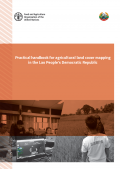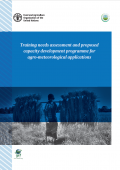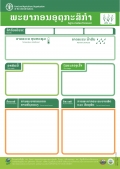Publications
2021
The leaflet presents the activities of the second component of the project “Strengthening Agro-climatic Monitoring and Information Systems (SAMIS) to improve adaptation to climate change and food security in Lao PDR”. In collaboration with The Department of Agricultural Land Management (DALaM) under the Ministry of Agriculture (MAF) has, with financial support of FAO Laos and technical support from International FAO experts, produced the first national agricultural land cover map in the country. It has been generated using a random forest machine learning approach to identify different land uses from satellite imagery and is in both, technical standard and accuracy, state of the art. The map includes major production systems of Lao PDR, including shifting cultivation. In its first released version, the following land cover classes are depicted: paddy rice, annual crops, steep slope agriculture (shifting agriculture), maize, cassava, sugarcane, tea plantations, coffee plantations, orchards and other plantations, sparse natural vegetation, dense natural vegetation, bare areas, built-up areas, and water surfaces. The pixel resolution of the map is 10m, while for temporal resolution images across the whole year of analysis are used. It is calibrated with 2,740 field observation data and has currently an estimated error of 10%, the acceptable norm based on FAO expertise.
2021
The Laos Climate Services in Agriculture (LaCSA) system was developed by the Department of Meteorology and Hydrology (DMH) project Strengthening Agro-climatic Monitoring and Information System (SAMIS). The LaCSA archives and processes agro-meteorological and climatological data to provide agro-advisory services to next- and end-users. It generates and delivers tailored agro-met services to farmers by analyzing the meteorological data, agriculture data from national databases, and field level data collected by partners to produce seasonal (monthly) and real-time (weekly) agro-advisory in the form of bulletins. The bulletins contain district- and province-specific crop and livestock forecasted climate risks, pest and diseases risk advisory, and climate smart farming recommendations. The production of the recommendations was undertaken by the National Agriculture and Forestry Research Institute (NAFRI) and by the CIAT project DeRISK. Jointly these entities collected and systematized detailed agricultural data and experts knowledge throughout the country. The recommendations went through a series of revisions and validations based on feedback from local crop experts. The agricultural recommendations (presented here in English but available in Lao language too) are structured in tables. Rows list the farming activity, and columns contain farming practices by rainfall forecast compared to the climatological average, for which three conditions are possible: normal, wetter than normal, and drier than normal.This leaflet aims to promote fair access and transparency for researchers, development partners, and advisory users. LaCSA is a dynamic system and information can be updated and modified based on new knowledge and need. Authorized representatives will improve the recommendations over time.

2020
This handbook presents the detailed steps for national agricultural land cover mapping, conducted with limited resources and budget from design to final validation and production. It covers the technical aspects of 1) selection and preprocess of satellite imagery (both optical and radar), 2) definition of a land cover legend using international standards, 3) the integration with other existing information as well as the analysis of such database in order to assign a thematic classification, 4) the interpretation, 5) the accuracy assessment and 6) the final packaging and publication of results. The handbook focuses on mapping agricultural land, in a complex landscape, such as the one found in Lao PDR, where atmospheric conditions, topographic effects and management makes the classification challenging. The handbook also presents practical examples of the team, software and skill-set required to develop a national land cover dataset. The objective of the document is to provide a working manual to other national teams willing to develop a land cover mapping programme.

2020
The project “Strengthening Agro-climatic Monitoring and Information Systems (SAMIS) to improve adaptation to climate change and food security in Lao PDR” has as its objective to enhance capacities to gather, process, analyse, and share climatic and geospatial information so that these can be applied to planning and decision-making. The present Training Need Assessment determines the training needs for the activities of the project related to the climatology database management, agro-meteorology and climate services preparation, as well as standard operating procedures. This document also discusses the procedure for implementing the training process including in-country and overseas trainings. This assessment has been developed focusing on the need of the Department of Meteorology and Hydrology (DMH) within the Ministry of Natural Resources and Environment but will benefit a multiplicity of national-level actors.

2020
The Food and Agriculture Organization (FAO) and the World Food Programme (WFP) are innovatively piloting the dissemination of agrometeorological services to teachers and students in schools. The pilot offers an opportunity to leverage the technical expertise of FAO and WFP, building on the FAO supported Strengthening Agro-climatic Monitoring and Information Systems (SAMIS) project and the WFP supported School Meals Programme implemented in partnership with the Ministry of Education and Sports (MoES). The existence of and investment in school gardens through the Schools Meals Programme offers a unique learning opportunity as well as model for scaling across the country.
